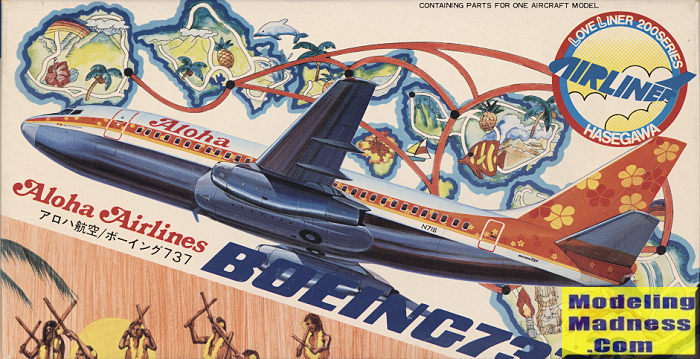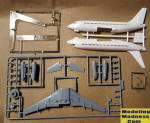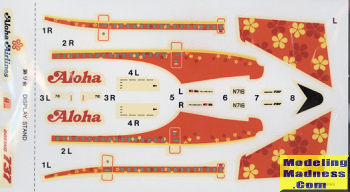
Hasegawa 1/200 B.737-200
| KIT #: | La006 |
| PRICE: | $ |
| DECALS: | One livery |
| REVIEWER: | Scott Van Aken |

| HISTORY |
The 737-200 was a 737-100 with an extended fuselage, launched by an order from United Airlines in 1965 and entered service with the launch customer in April 1968. Its unit cost was US$4.0M (1968) ($29.4M today). The -200's unit cost was US$5.2M (1972) ($31.8M today). The 737-200 Advanced is an improved version of the -200, introduced into service by All Nippon Airways on May 20, 1971. After aircraft #135, the 737-200 Advanced has improved aerodynamics, automatic wheel brakes, more powerful engines, more fuel capacity, and hence a 15% increase in payload and range over the original -200s and respectively -100s. The 737-200 Advanced became the production standard in June 1971. Boeing also provided the 737-200C (Combi), which allowed for conversion between passenger and cargo use and the 737-200QC (Quick Change), which facilitated a rapid conversion between roles. The 1,095th and last delivery of a -200 series aircraft was in August 1988 to Xiamen Airlines.
Nineteen 737-200s, designated T-43, were used to train aircraft navigators for the U.S. Air Force. Some were modified into CT-43s, which are used to transport passengers, and one was modified as the NT-43A Radar Test Bed. The first was delivered on July 31, 1973, and the last on July 19, 1974. The Indonesian Air Force ordered three modified 737-200s, designated Boeing 737-2x9 Surveiller. They were used as Maritime reconnaissance (MPA)/transport aircraft, fitted with SLAMMAR (Side-looking Multi-mission Airborne Radar). The aircraft were delivered between May 1982 and October 1983.
After 40 years, in March 2008, the final 737-200 aircraft in the U.S. flying scheduled passenger service were phased out, with the last flights of Aloha Airlines. The variant still sees regular service through North American charter operators such as Sierra Pacific. With the improved short-field capabilities of the 737-200, Boeing offered the option of the gravel kit modification features preventing foreign object damage, which enables this aircraft to operate on remote, unimproved or unpaved runways, such as gravel runways, that other similarly sized jetliner cannot. Until retiring its -200 fleet in 2007, Alaska Airlines used this option for some of its combi aircraft rural operations to serve many unimproved runways in Alaska. Gravel-kitted 737-200 Combis are still used by Canadian North, Air Inuit, Nolinor, Chrono and Air North in Northern Canada where gravel runways are common.
In July 2019, there were 46 Boeing 737-200s in service, mostly with "second and third tier" airlines, and those of developing nations.
| THE KIT |
 Back in 1980, Hasegawa released a number of
then-current airliner kits in 1/200
scale. These included the 727-200, 737-200, 747-400, DC-10-30, L.1011, and
DC-9-30 to name a number of them. These were mostly provided with Japanese
liveries, but there were some others in the mix. 1/200 was a perfect scale for
those who did not have the space to display a 1/144 kit, which was the case for
most Japanese homes/apartments.
Back in 1980, Hasegawa released a number of
then-current airliner kits in 1/200
scale. These included the 727-200, 737-200, 747-400, DC-10-30, L.1011, and
DC-9-30 to name a number of them. These were mostly provided with Japanese
liveries, but there were some others in the mix. 1/200 was a perfect scale for
those who did not have the space to display a 1/144 kit, which was the case for
most Japanese homes/apartments.
These were all quite nicely done and pretty much the same basic engineering. No cockpit is provided and while there is a clear cockpit windscreen assembly, there are no cabin windows, just openings. This is fine for this scale. The kits also provided the required weight for the nose, though many also included display stands, in which case the weight would not be needed. This kit does not provide a metal weight, instead it has a large chunk of plastic molded as a forward bulkhead that provides sufficient weight to keep it on its wheels.
In the case of the 737, the wings are a single piece that includes the main
gear wells. Also a single piece are the tailplanes. Landing gear are fairly
hefty for the scale and have separate wheels, which are a bit of a
 challenge to
paint due to their size. Nose gear doors are molded in place so there is no 'in
flight' option so the builder has to cut them away and fill the opening with the
removed bits. The kit does provide a display stand, which for the larger planes
is a tad wobbly, but is fine for a light model such as this. Engines are simply two
halves with a forward compressor blade.
challenge to
paint due to their size. Nose gear doors are molded in place so there is no 'in
flight' option so the builder has to cut them away and fill the opening with the
removed bits. The kit does provide a display stand, which for the larger planes
is a tad wobbly, but is fine for a light model such as this. Engines are simply two
halves with a forward compressor blade.
This particular boxing is for Aloha Airlines and while the decals are old and yellowing, could be salvaged. Conversely, finding aftermarket for this plane is not difficult as many do sheets for this aircraft. The instructions are in Japanese, but this is a fairly simple kit so will not prove any detriment to building the kit.
| CONCLUSIONS |
Back in the early 1980s, I built a lot of these 1/200 airliner kits, most of them in Minicraft boxes as that is what was carried at the exchange. They are easy to build, easy to paint (relatively) and looked very nice when done. A brief check via Google shows that these can be found, but sellers want stupid money for them. Much better chance of finding one at a reasonable price from a vendor at a show.
| REFERENCES |
https://en.wikipedia.org/wiki/Boeing_737#737-200
November 2024
Copyright ModelingMadness.com. All rights reserved. No reproduction without express permission from the editor.
If you would like your product reviewed fairly and fairly quickly, please contact the editor or see other details in the Note to Contributors.